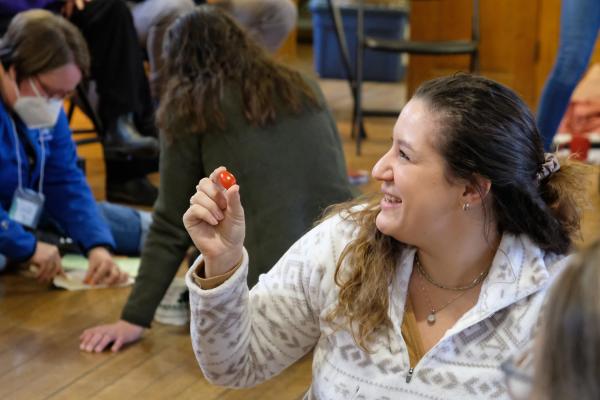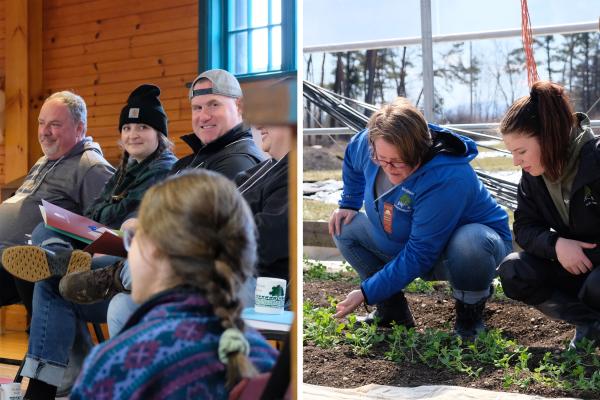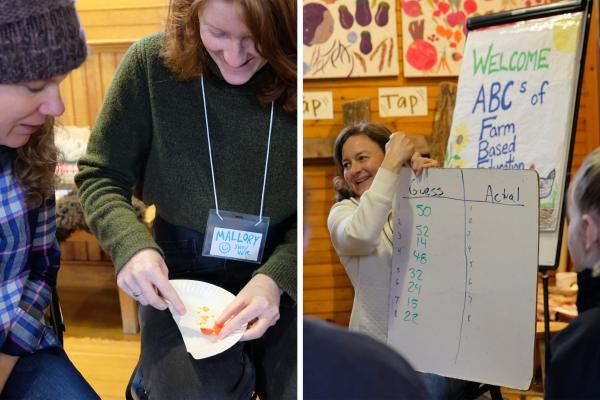Tomato Planet Activity
We know connecting people to food–where it comes from, who grows it, and how it’s grown–is essential for shaping a more sustainable future. Twice a year, farm-based educators from around the country join us at Shelburne Farms to learn strategies for doing exactly that.
In the ABCs of Farm-Based Education program, educators immerse in learning on our campus, gaining new ideas for engaging and inspiring visitors using their own farms and gardens, often learning as much from each other as they do from our facilitators. This spring, 19 educators from North Carolina, Pennsylvania, Massachusetts, Connecticut, Vermont, and New York joined us for three days of learning in our Education Center, Children’s Farmyard, forest classroom, Market Garden and Sugarhouse, and Dairy.
“This program is so special because we know hundreds of farms have taken what they’ve learned in ABCs over the years back to their own communities, and helped visitors connect to agriculture and nature. There’s a real ripple effect,” shares Vera Simon-Nobes, coordinator of the Farm-Based Education Network and facilitator of ABCs.
In the words of two of this spring’s participants:
"I loved connecting with other educators and sharing about all of the different programs that they're working on, things that bring excitement, and challenges to talk through."
"I was able to see and live a vision I have only dreamed of. The activities as a group were very engaging and I will be taking lots of new ideas back to the classroom!"
Here’s one of the activities that we shared with ABCs attendees, called Tomato Planet, originally published in the resource book Project Seasons by Deb Parrella. You can do this activity with your own young learners, in a classroom setting or at home. While our instructions suggest using a cherry tomato, you could use any seasonal fruit, says facilitator Susie Marchand. To prevent food waste, practice good hand washing before handling your tomato. Once your tomato is dissected, enjoy it as a snack, either on its own or by adding it to a sauce or salsa!
Activity: Tomato Planet
Learn about seed survival and what seeds need to grow. This activity has two parts: discovering how many seeds are in plants, and learning what seeds need to grow.
We love introducing this activity with A Fruit is a Suitcase for Seeds by Jean Richards.
Materials
- Cherry tomatoes
- Plates and kid-friendly knives (To reduce waste, we often use compostable butter knives and paper plates cut in half.)
- Index cards (one per learner) and a writing utensil
- Four “bases” in an indoor or outdoor space
Download Tomato Planet as a PDF.
Directions, Part I
- Ask, what’s inside the fruits of plants? (Seeds.) How many seeds are inside? Do you think similar fruits have a similar number of seeds? (It can vary from plant to plant.) Explain that learners will do an activity to find out about the number of seeds produced by a plant and how this relates to seed survival.
- Depending on the size of your group, this activity can be done individually or in pairs. Give each learner or pair a cherry tomato. How many seeds do they think are inside? Record each guess on a flipchart or whiteboard, and review everyone’s guesses.
- Next, distribute paper plates and knives. Have learners cut their tomato in half and count the seeds inside. This is a great part to do in pairs! Ask them to add up the total number of seeds. How did this compare with their prediction? Review and record the totals.
Directions, Part II
- Ask, how many seeds does it take to grow one tomato plant? (Just one seed.) Write the word “seed” on an index card. Ask, what kinds of things will help this seed germinate and grow into a healthy plant? (Plenty of sunshine, enough space, good soil, enough water, fertilizer, weeding, etc.) Record each idea on an index card. When you’ve listed as many growth conditions as the group can generate, duplicate or triplicate the cards until you’ve filled ⅔ of all the cards.
- How many tomato plants could they potentially grow from their cherry tomato? (The same number of plants as seeds.) Ask, why aren’t tomatoes growing everywhere? Record possible hazards to the seed germination and growth on remaining index cards. (Drought, too cold, too wet, competition from other plants, disease, some are eaten, etc.)
- Now, for movement! Learners will enact the risky life of a little seed. Pass out one index card to each student. Explain that they should each look at their card but keep the information on it–a seed, or a positive or negative growth condition–a secret. In an outdoor or indoor space, set up four equally spaced bases. Explain that when you say “Go!”, they should run around the bases in a circle. When you say “Stop!” they should run to the nearest base. (You can also cue this by playing and pausing music.)
- Ask learners to reveal their cards to others on their base. Have them determine whether or not a seed would be able to survive and grow in this spot. Check the conditions on each base. What are you missing?
- Collect the cards, reshuffle, and distribute them to play another round!
Join us for the next session of ABCs of Farm-Based Education, happening at Shelburne Farms October 22–24.



